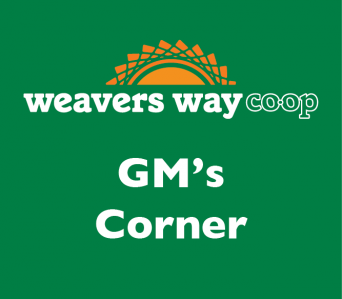
GM's Corner: In A Time of Changing Grocery Fads, Co-ops Can Be Islands of Stability
As owners of a grocery store, you may be interested to know that industry experts — their opinions are multitudinous and voluminous, and on occasion, they are even correct — believe we are in a period of “disruption.” I’d say it’s more of an “evolution,” but when an industry with $6 trillion in annual sales experiences change, all of us should probably pay attention.
New players are getting into the game. Grocers are experimenting with new formats. Product mixes are shifting to accommodate consumer tastes. And in an industry with an overabundance of competition and razor-thin profit margins, everyone is struggling to figure out how to set themselves apart from the pack.
The evolution of the grocery biz is apparent here in Philadelphia. And whether you find recent changes exciting or troubling depends largely on your vantage point.
Philadelphia is not a “food desert,” as defined by the USDA. (If you live more than one mile from a supermarket, the USDA considers your neighborhood a food desert. Congratulations.) There are neighborhoods that lack healthy and affordable food options, and certainly too many Philadelphians are food insecure, which is a topic for a different column. But there are lots of places to buy groceries in our city.
In Center City and the affluent neighborhoods that surround it, you’ll find much of the grocery industry’s disruption. Here, food retailers are killing each other to garner and protect their piece of the action. Whole Foods has two stores; so does Trader Joe’s. There are four Heirloom Markets, a Sprouts, and a bunch of independent operators. Competition in and around Center City will only increase in the years ahead. Consumers will have lots of options.
Outside Center City, the battlewagons of the city’s grocery industry are its conventional supermarkets: 16 Acmes, 14 Shop Rites, seven Fresh Grocers, and a few Giants and IGAs thrown in for good measure. These stores serve the city’s working class, using more or less the same model they’ve used for the past several decades.
The conventional markets are being squeezed by a wave of new arrivals. There are now five Walmarts and 11 Targets in the city, many with full-blown grocery stores within them, but all devoting at least some space to food. Aldi, the German discount grocer, now operates nine stores in the city, and its principal competitor, Lidl, just opened its first (with more on the way).
Increasingly, many city residents, especially in the poorest neighborhoods, are buying their food at dollar stores: In Philadelphia, there are 20 Dollar Generals, 19 Family Dollars, and 18 Dollar Trees. At dollar stores like these, product offerings tend to be limited, with fresh and whole foods often crowded out by processed junk.
Looming over all these changes is Amazon. More and more frequently, consumers are turning to Amazon for non-food items they used to buy at grocery stores: paper towels, diapers, laundry detergent and the like. And now Amazon wants your food dollars, too.
But Amazon has already made the decision that it cannot dominate the grocery industry with its online platform only. Food isn’t like books or shoes. People want to smell, squeeze, and taste before they buy. When it comes to grocery shopping, the senses still matter.
So for the first time in its history, Amazon is investing heavily in brick-and-mortar shops. First they bought Whole Foods. Now they are experimenting with Amazon Go, a check-out free convenience store (look out, Wawa), and have announced a new chain of conventional markets to compete with the likes of Acme and Wegmans. With near limitless resources and a corporate culture obsessed with rapid growth, they’ve got the industry on edge.
So the times are indeed changing.
Of course, in considering all these changes, we cannot forget about Philadelphia’s amazing independent food retailer scene. Reading Terminal Market is still going strong. Highly successful farm markets such as Head House Square and Clark Park are just the top examples of dozens of farm markets that operate throughout the city. There are specialty shops such as Claudio’s and DiBruno Brothers, and an abundance of ethnic markets such as Rieker’s, H-Mart, and Netcost.
And above all, there are the co-ops. Weavers Way’s two city stores are joined by Mariposa Food Co-op in West Philadelphia, Kensington Community Food Co-op on Lehigh Avenue, and, opening soon, the South Philly Food Co-op at Snyder and Juniper.
The co-ops are a reminder that a community that owns its grocery store is protected from the fickle whims of an industry in flux. Corporate chains will come and go. Amazon will sell you groceries until it decides it doesn’t want to anymore. But a co-op — as long as it’s well run — can approach disruption with the serene confidence of knowing our shoppers own the place.
Some things never change.
See you around the Co-op.
